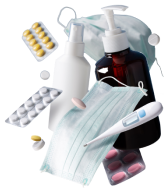Healthwire Pharmacy provides 100% genuine medicines straight to your doorstep.
Order Now! & Avail
Upto 10% OFF On All Your Pharmacy Orders!
Healthwire Pharmacy Ratings & Reviews (1500+)
Product Information
Terbinafine cream, when applied topically, exerts its antifungal activity primarily by inhibiting a key enzyme called squalene epoxidase. This enzyme plays a crucial role in the biosynthesis of ergosterol, a vital component of the fungal cell membrane. By blocking the action of squalene epoxidase, terbinafine disrupts the production of ergosterol, leading to the accumulation of squalene and other sterol intermediates within the fungal cell. This disruption in sterol synthesis weakens the cell membrane integrity of susceptible fungi, ultimately resulting in fungal cell death. The selective inhibition of squalene epoxidase makes terbinafine highly effective against a range of dermatophytes and certain other fungi, while minimizing adverse effects on human cells, which do not rely on ergosterol for their membrane structure.
Antifungal
Cream
The following are the uses of Terbinafine Cream:
Tailoring Treatment for Optimal Health, Prescribed Medication Dosage is:
In the case of an overdose of Terbinafine Cream, it is important to note that the cream is for topical use only, and the risk of adverse effects from excessive application is low. However, if someone has ingested a large amount of the cream, they may experience gastrointestinal symptoms such as nausea, abdominal pain, or diarrhea. In such instances, contacting a healthcare professional or poison control center is recommended for further advice and to determine the appropriate course of action.
In the case of a missed dose of Terbinafine Cream, it is important to apply the medication as soon as you remember. However, if it is almost time for your next dose, skip the missed one and continue with your regular dosing schedule. Do not apply extra cream to make up for the missed dose, as this may increase the risk of side effects. If you frequently miss doses, consider setting reminders or asking someone to remind you to help maintain consistency in your treatment plan. Consult your healthcare provider if you have any concerns or questions regarding missed doses and the proper usage of Terbinafine Cream.
To apply Terbinafine Cream, clean and dry the affected skin area, then apply a thin layer of the cream, gently rubbing it into the skin once or twice daily, or as directed by your healthcare provider, covering the entire affected area and its immediate surrounding skin.
Here are the conditions and situations when Terbinafine Cream should not be used:
The side effects of Terbinafine Cream may include:
Following are the precautions and warnings for Terbinafine Cream:
Following are the drug interactions for Terbinafine Cream:
Following are the food interactions to be aware of when using Terbinafine Cream:
Terbinafine Cream should be stored in a cool and dry place, preferably at room temperature (around 20-25°C), away from direct sunlight and moisture. Keep the cream in its original container, tightly sealed, to maintain its integrity and prevent contamination. Avoid storing it in bathrooms or kitchens, as temperature fluctuations and humidity can impact its effectiveness. Pay attention to the expiration date on the packaging, and do not use the cream beyond this date. When disposing of any leftover or expired Terbinafine Cream, do not flush it or pour it down the drain. Instead, follow local guidelines or consult a pharmacist for safe disposal methods to minimize environmental impact. Ensure the cream is kept out of children's reach to prevent accidental exposure.
Following are the quick tips for Terbinafine Cream:
Terbinafine 1%, a physician-prescribed antifungal medication, is commonly used to treat skin and nail fungal infections. This medication is generally safe and effective, but some laboratory tests may be required while taking Terbinafine 1%. These tests are precautionary and not related to the medication itself. These tests may include liver function tests to monitor liver enzyme levels, as Terbinafine is metabolized by the liver. Kidney function tests may also be ordered to assess your kidney function cautiously. Terbinafine can cause abnormalities in white blood cell counts, especially in cases of rare allergic reactions, and monitoring complete blood counts can identify changes in blood cell levels. In certain cases, your doctor may order serum concentration tests to monitor Terbinafine levels in your blood, particularly if you weigh less than 60 kg or have concurrent diseases that may affect drug absorption or metabolism. These tests are to ensure that Terbinafine 1% effectively treats your fungal infection while safeguarding your overall health. It's important to note that not all individuals taking Terbinafine 1% will require these tests. Your doctor will determine which, if any, laboratory tests you will need based on your medical condition, age, and other factors. If you have any concerns or questions regarding the tests you may need while taking Terbinafine 1%, consult your healthcare provider.

Order Now! & Avail
Upto 10% OFF On All Your Pharmacy Orders!

If you face any issue, feel free to contact us. We provide 24/7 support to assist your problems